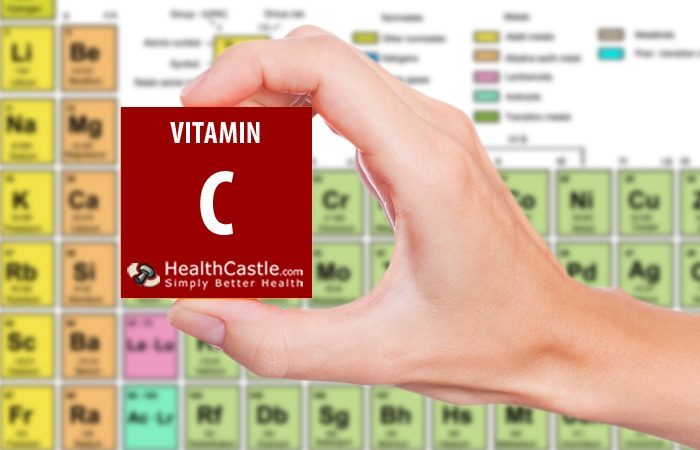
Written By: Carolyn Berry, RD
Title: Registered Dietitian
Alumni: University of British Columbia
Last Updated on:

Vitamin C, also known as ascorbic acid, is a water-soluble vitamin, meaning that your body doesn’t store it. It is found in high amounts in many fruits and vegetables. Scurvy (Vitamin C deficiency) was first discovered in British sailors who were not consuming many foods that contained Vitamin C. From then on they carried Vitamin C–packed limes on their voyages.
Table of Contents
The Dietary Reference Intakes (DRI) for Vitamin C are shown below:
| Age Group | Recommended Dietary Allowance (RDA) per Day1 | Tolerable Upper Intake Level (UL) per Day2 |
| Adults | ||
| 19 years and up | 90 mg male 75 mg female | 2,000 mg |
| Kids and Youth | ||
| 1 to 3 years | 15 mg | 400 mg |
| 4 to 8 years | 25 mg | 650 mg |
| 9 to 13 years | 45 mg | 1,200 mg |
| 14 to 18 years | 75 mg male 65 mg female | 1,800 mg |
| Special Considerations | ||
| Pregnant women 14 to 18 years | 80 mg | 1,800 mg |
| Pregnant women 19 years and up | 85 mg | 2,000 mg |
| Lactating women 14 to 18 years | 115 mg | 1,800 mg |
| Lactating women 19 years and up | 120 mg | 2,000 mg |
People who smoke and those who are exposed to secondhand smoke need 35 mg more Vitamin C per day than nonsmokers. Cigarette smoke increases the amount of Vitamin C that the body needs to repair damage caused by free radicals.

Vitamin C has a very important protective effect on the body. Like many other plant-based nutrients, including Vitamin E and beta-carotene, Vitamin C is an antioxidant. Antioxidants block some of the damage caused by free radicals, substances that damage DNA, the body’s genetic material. Over time, the accumulation of free radicals may contribute to the aging process and the development of a number of health conditions such as cancer, heart disease, arthritis, and cataracts.
Vitamin C also assists in the formation of collagen3, a protein which is important for the health of blood vessels and gums, development of bones and teeth, and wound healing. In addition, Vitamin C improves the absorption of iron from plant-based foods and helps the immune system work properly to protect the body from disease.
Vitamin C deficiency is rare in North America. People who get little or no Vitamin C for many weeks can develop scurvy. Scurvy causes fatigue, depression, swollen and/or bleeding gums, loosening or loss of teeth, small red or purple spots on the skin, joint pain, poor wound healing, corkscrew hairs, and anemia. Scurvy is fatal if it is not treated.
Taking too much Vitamin C is also rare. When it occurs, it can lead to diarrhea, nausea, and stomach cramps. In people with a condition called hemochromatosis, which causes the body to store too much iron, high doses of Vitamin C could worsen iron overload4 and lead to the damage of body tissues.
Vegetables and fruit are the best sources of Vitamin C.
| Food | Vitamin C per serving |
| Guava, 1/2 cup | 188.3 mg |
| Bell pepper, red, raw, chopped, 1/2 cup | 95.1 mg |
| Kiwi fruit, sliced, 1/2 cup | 83.4 mg |
| Papaya, mashed, 1/2 cup | 70 mg |
| Lychee, 1/2 cup | 67.9 mg |
| Brussels sprouts, cooked, 4 sprouts | 64.6 mg |
| Orange juice, 1/2 cup | 62.0 mg |
| Bell pepper, green, raw, chopped, 1/2 cup | 59.9 mg |
| Navel orange, 1/2 cup | 48.8 mg |
| Strawberries, sliced, 1/2 cup | 48.8 mg |
| Grapefruit, 1/2 fruit | 45.5 mg |
| Broccoli, raw, chopped, 1/2 cup | 40.6 mg |
| Pineapple, chunks, 1/2 cup | 39.4 mg |
| Cabbage, red, raw, 1/2 cup | 25.4 mg |
In the United States: The daily value (DV) for Vitamin C is 90 mg5. The number you see on the Nutrition Facts label is a percentage calculated by dividing the amount of Vitamin C in one serving of the food by the DV. Using an example from the above chart, ½ cup of mashed papaya, which contains 70 mg of Vitamin C, would have 78% of the DV for Vitamin C. The FDA requires that the DV for Vitamin C be listed on the Nutrition Facts label.
In Canada: The daily value for Vitamin C in Canada is also 90 mg6. Canadian labeling laws also require that the DV for Vitamin C be listed on the Nutrition Facts label.
Iron: Vitamin C (from food sources and/or supplements) increases the absorption of iron when taken at the same time.
Copper: Supplemental intake of Vitamin C at very large doses (1,500 mg daily) can interfere with copper metabolism.
Vitamin E: Vitamin C is involved in the regeneration of Vitamin E, and these two vitamins appear to work together in their antioxidant effect.
HealthCastle has strict sourcing guidelines. We reference peer-reviewed studies, scientific journals and associations. We only use quality, credible sources to ensure content accuracy and integrity.
Alumni: University of British Columbia – Carolyn Berry is a Vancouver-based Registered Dietitian, self-proclaimed foodie, marathon runner, and owner of Berry Nourished. Carolyn works in a variety of areas including clinical nutrition, outpatient counselling at Medisys Preventive Health Clinic, as a nutrition tour leader with Save-On-Foods, and in the media, including segments on CBC Television, CKNW and Spice Radio. Through informative and practical nutrition advice and her food-first approach to health, Carolyn fulfills her passion to empower others with knowledge about nutrition so that they can make the best decisions to improve their health. She strongly believes that food should be both healthful and delicious.
antioxidant, micronutrient - vitamins, vitamin c, vitamins